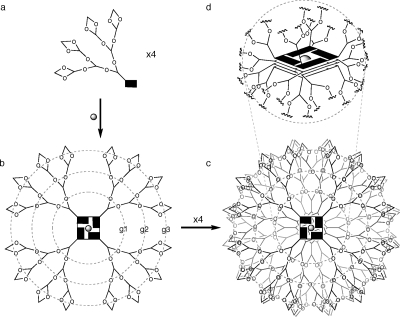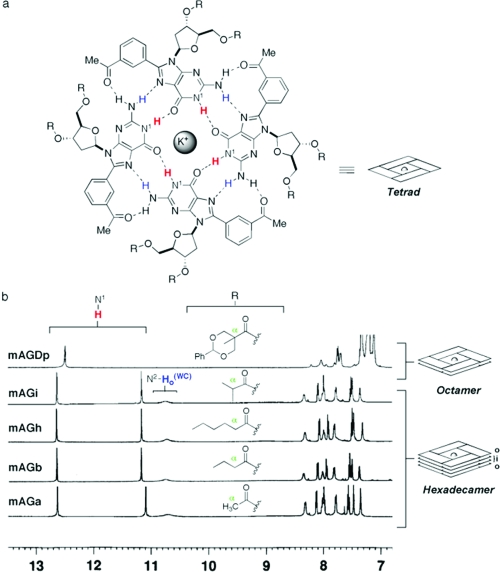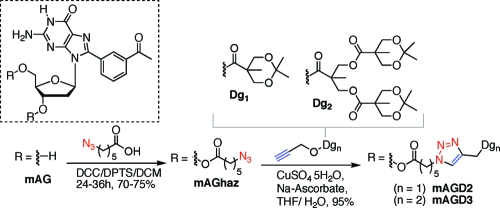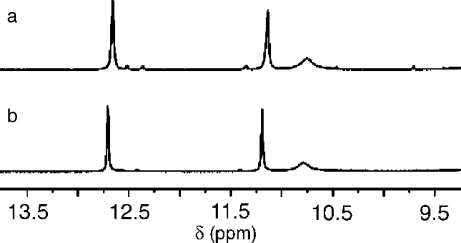Abstract

Herein we describe the construction of hexadecameric self-assembled dendrimers (SADs) using a series of dendronized 8-(m-acetylphenyl)-2′-deoxyguanosine (mAG) subunits. The azido-substituted mAG subunits were covalently linked to alkynyl polyester dendrons using a copper-catalyzed 1,3-dipolar cycloaddition reaction. Discrete SADs are formed with high fidelity and thermal stability even with the increased steric hindrance offered by the dendrons.
Dendrimers are “tree-shaped” monodispersed macromolecules characterized by having “branches” or dendrons that grow from a central core. Their overall size, shape, and morphology is determined by the branching pattern, the nature of both the branching and surface groups, as well as the number of layers surrounding the core.(1) These characteristics make dendritic structures suitable platforms for applications in light-harvesting, catalysis, cellular imaging, and drug delivery.(2) Their ideal hyperbranched structures also make their synthesis more challenging than that of most polymers. Although their preparation has improved significantly over the past decade, the larger and more complex structures still require significant synthetic efforts that are often plagued by low yields and polydispersity. In a seminal work, Zimmerman and co-workers tackled this problem by using self-assembly to construct a series of discrete and well-defined hexameric self-assembled dendrimers (SADs).(3) The self-correcting nature of SADs have made them increasingly useful in the construction of complex multifunctional supramolecules.1b,4
The construction of SADs rely primarily on two strategies: (1) the self-recognition of subunits and (2) the assembly of multiple subunits onto a core, which in itself can be a dendrimer.4,5 Most SADs reported to date rely mainly on the use of one type of noncovalent or reversible covalent interactions. The former include hydrogen bonds and stacking/hydrophobic interactions(6) or mechanical bonds,(7) whereas the latter rely most often on the use of coordinative bonds.(8) Nevertheless, most SADs reported to date are of relatively low molecularity (six subunits or less)(9) or are dendritic structures of indefinite molecularity (e.g., liquid crystals).(10) Herein we report the synthesis of dendronized 8-(m-acetylphenyl)-2′-deoxyguanosine (mAG) derivatives and their use in the construction of well-defined and discrete SADs of relatively large molecularity (16 subunits).
Guanosine and related compounds have a propensity to form planar tetramers (G-tetrads, Figure 1), which are held together by hydrogen bonds and cation complexation; further stacking of such tetrads leads to structures known as G-quadruplexes.(11) Previously we have demonstrated that the self-assembly of lipophilic dG-derivatives could be modulated by replacement of the H8 in the guanine base with a functionalized phenyl group.(12) The position of the functional group in the phenyl ring controlled the stoichiometry, thermal stability, and in some cases their selective binding for metal cations.12,13 Taking advantage of our familiarity with these derivatives, we embarked on the construction of other nanostructures such as dendrimers.(14)
Figure 1.
Hierarchical formation of a self-assembled dendrimer (SAD). (a) Dendronized mAG subunits self-assemble into (b) disk-like tetramers, which (c) further stack to form hexadecameric SADs. (d) The resulting SADs have a functional core composed of a modified lipophilic G-quadruplex.
In particular we have discovered that the mAG scaffold shows a strong tendency to self-assemble into a hexadecamer in the presence of KI under a wide variety of conditions. In order to test the tolerance of the mAG scaffold to substitutions in the sugar we evaluated the self-assembly in CD3CN of derivatives having ester groups with alkyl chains of different sizes (Figure 2). Having acetyl (mAGa), straight alkyl chains (mAGb, mAGh), or even groups with α-branching (mAGi) have no detrimental effect in the formation of a hexadecamer. Nonetheless, the increase steric repulsion caused by the α-branching in mAGi induces a slight decrease in the thermal stability (3.5 °C lower) of the resulting hexadecamer as compared to the one formed by mAGa (unpublished results). Remarkably, although the quaternary α-carbon and the bulky aromatic group in mAGDp prevent the formation of a hexadecamer, the compound is still able to self-assemble into an octamer. This results prompted us to install hexanoyl spacers between the 2′-deoxyribosyl moiety and aliphatic polyester dendrons derived from 2,2-bis(hydroxymethyl)propionic acid (bis-MPA).(15)
Figure 2.
(a) Chemical structure of the mAG tetramer and (b) partial 1H NMR spectra (500 MHz, CD3CN, 295 K) of mAG derivatives with different substitutions on the 2′-deoxyribosyl moiety. All of the substituents enable the formation of hexadecamers except mAGDp, which forms an octamer. The hexadecamers show a signature of doubled set of resonances due to the two sets of tetrads that are in different chemical environments (o = outer, i = inner). The peaks in the region of 11−13 ppm correspond to the N1H (red), and the broad peak at around 10.8 ppm corresponds to the N2H (blue) on the Watson−Crick edge of the guanine moiety.
The synthesis of the dendronized derivatives was performed as described in Scheme 1. The mAG derivative was prepared in high yield via a Suzuki−Miyaura coupling as previously described.(12) Esterification of mAG with 6-azidohexanoic acid afforded the azide-containing derivative (mAGhaz), and subsequent reaction with alkynyl-containing dendrons via the efficient copper-catalyzed Huisgen 1,3-dipolar cycloaddition reaction (aka “click” reaction) furnished the dendronized derivatives mAGD2 and mAGD3 in good yields.15–17 As a result of the bifunctional nature of the mAG scaffold, the resulting dendronized derivatives are one generation number higher than the alkynyl-containing dendrons used. For example, coupling of two alkyne dendrons Dg1 leads to the formation of mAGD2. This is very attractive as it implies that we could build large dendrimers starting from relatively small dendrons.
Scheme 1. Synthesis of Dendronized mAG Derivatives.
Both derivatives mAGD2 and mAGD3 show sharp and well-defined signals in DMSO-d6, which is indicative of mostly noninteracting monomeric species and expected with such a highly competitive solvent. Similarly, in CD3CN all peaks are sharp and well-resolved with the exception of the N1H peaks, which are slightly exchange-broadened, indicating the formation of loosely bound aggregates (Supporting Information, Figures S1 and S2). For both compounds, addition of 0.0625 equiv of KI induces the appearance of a new set of peaks that are sharper and correspond to the formation of an octamer. Further addition of KI (0.125−0.5 equiv) leads in both cases to the appearance of a hexadecamer as evidenced by the splitting of every signal of the spectrum into pairs of peaks. For both mAGD2 and mAGD3, the difference in the chemical shift for the imino (N1H) protons of the inner and outer tetrads is about 1.6 ppm, reflecting the anisotropic shielding of the inner tetrads relative to the outer tetrads (Figure 3).
Figure 3.
1H NMR spectra (500 MHz, CD3CN, 298 K, 0.5 equiv of KI) of (a) (mAGD2)16 and (b) (mAGD3)16.
After addition of 0.5 equiv of KI, both mAGD2 and mAGD3 form hexadecamers with high fidelity, and their spectra is very reminiscent of that of the mAG derivatives shown in Figure 2. This underscores the fact that the mAG scaffold is very robust to substitutions in the 2′-deoxyribosyl moiety.
To confirm the molecularity of the resulting SADs we performed vapor pressure osmometry (VPO) measurements. Although VPO is not as accurate as other techniques such as mass spectrometry (MS), it does offer the advantage of performing measurements in solution under conditions (concentration, temperature, etc.) that are very close to those used in NMR experiments. As seen in Table 1 (using mAGi as a reference), samples of both mAGD2 and mAGD3 give results that are consistent with a hexadecamer templated by three potassium cations. Furthermore, although the difference between the theoretical and the measured values (ΔMW) may seem large, it is less than half the molecular weight of one subunit.
Table 1. Molecular Weight (MW) for Assemblies As Determined by VPO in CH3CN (40 °C).
| derivativea | MW |
|MW| | |
|---|---|---|---|
| theoretical | VPO | ||
| (mAGi)16·3KI | 8907 | 8661 | 246 |
| (mAGD2)16·3KI | 17908 | 18432 | 523 |
| (mAGD3)16·3KI | 26622 | 26048 | 574 |
Measured in a concentration range of 35−50 mM.
Nevertheless, we performed PFG-NMR experiments to further confirm the results from VPO.(18) As expected, the hexadecamer formed by mAGi gives a diffusion coefficient (D) that is higher than those of mAGD2 and mAGD3 (Table 2). Surprisingly, the values of D for both SADs are practically identical within the margin of error. This phenomenon might be explained by the reported back-folding of the terminal groups in dendrimers, which are known to distribute themselves throughout the volume of the dendrimer.(19) This causes larger dendrimers to become more compact with increasing generation numbers.
Table 2. Diffusion Coefficients (D) and Hydrodynamic Radii (r) of SADs and Other Substances As Determined by PFG-NMR in CD3CN.
| substance | D (10−10 m2 s−1) | r (Å) | Dsub/Dstd |
|---|---|---|---|
| adenosine standarda | 12.704 ± 1.358 | 5.04 ± 0.47 | |
| (mAGi)16·3KI | 6.430 ± 0.114 | 9.96 ± 0.05 | 0.506 |
| (mAGD2)16·3KI | 4.463 ± 0.199 | 14.43 ± 0.19 | 0.351 |
| (mAGD3)16·3KI | 4.600 ± 0.345 | 13.93 ± 0.34 | 0.362 |
See Supporting Information for structural details.
Moreover, 2D-NOESY experiments provide evidence that the hexadecameric SADs formed by mAGD2 and mAGD3 are isostructural to those shown in Figure 2. Although, as mentioned above, the dendrons have a tendency to agglomerate throughout the volume of the dendrimer, the quadruplex core remains largely unchanged. This is apparent in the signature cross peaks observed in the 2D-NOESY spectra (Supporting Information, Figure S4). The core of the resulting SADs result from the arrangement of 16 subunits packed into four stacked tetrads with three collinear potassium cations located down a central channel. The preferential formation of such resilient supramolecular structures requires the concerted work of multiple noncovalent interactions (hydrogen bonds, cation-dipole, and Van der Waals interactions).
The thermodynamic stability of such SADs can be assessed by variable concentration (VC) and variable temperature (VT) experiments. Dilution experiments in CD3CN allowed us to evaluate the range of concentrations over which the SADs remain largely assembled with high fidelity. We use the ratio (f) of ordered species formed by mAGD2 and mAGD3 to simplify the comparison between supramolecules of different molecularities (Supporting Information, Figures S5 and S6, Table S1). In the concentration range between 30 and 10 mM (concentration of the individual subunits), f remains effectively constant for both SADs. However, dilution below 10 mM causes the hexadecamer to vanish rapidly with the concomitant appearance of a monomeric species. Nonetheless, even at 1 mM there is a visible amount of hexadecamer (25% for mAGD2 and 23% for mAGD3) indicating the robustness of the system. Although at the lowest concentrations the presence of octamers and dodecamers are visible, it seems that the disassembly occurs cooperatively and most of the subunits become monomeric without populating either one of those states.(12)
Parallel VT experiments were performed with 5 mM solutions in CD3CN. We chose this particular concentration as it offers a good mixture of monomers to SADs that is suitable to NMR analysis (Supporting Information, Figures S7 and S8, Table S2). Although the hexadecameric SADs formed by both mAGD2 and mAGD3 essentially disappear at temperatures above 323 K, at 328 K there is still a significant amount of octameric SADs visible. Both VC and VT experiments confirm that the increased steric bulk of the SAD formed by mAGD3 relative to the one formed by mAGD2 induces slight decrease in the thermodynamic stability.
The versatility of this approach for the construction of dendrimers is illustrated by the fact that a hexadecameric SAD of mAGD3 (obtained from the coupling of Dg2) displays 128 protected oxygens at its periphery. In contrast, to achieve the equivalent with a fully covalent dendrimer will require, for example, the synthesis and coupling of four fifth-generation dendrons (e.g., Dg5) to a tetrafunctional core (e.g., a porphyrin).(20) Furthermore, these SADs are discrete, well-defined, easy to make, chiral, and thermally stable and have a functional core.(21) The fact that these SADs are sustained by multiple noncovalent interactions enables the fine-tuning of their structure and dynamics by using a wide variety of external stimuli. Studies aimed at doing the latter as well as evaluating the encapsulation of guest molecules are currently underway.
Acknowledgments
We thank Dr. Vladimir Gubala (UPRRP), Andrés González (UPRRP), and Medardo Rosario (UPRRP) for helpful technical assistance during the initial stages of this work. J.E.B. thanks the AGEP-PR program (No. 0302696) for financial support. This publication was made possible by Grant No. P20 RR016470 from the National Center for Research Resources (NCRR), a component of the National Institutes of Health (NIH). Its contents are solely the responsibility of the authors and do not necessarily represent the official views of the NCRR or NIH.
Supporting Information Available
Detailed synthetic procedures, characterization data for all new compounds, experimental protocols, and NMR titration data. This material is available free of charge via the Internet at http://pubs.acs.org.
Funding Statement
National Institutes of Health, United States
Supplementary Material
References
- a Newkome G. R.; Moorefield C. N.; Vogtle F.. Dendritic Molecules: Concepts, Synthesis, Perspectives; VCH Publishers: New York, 1996. [Google Scholar]; b Zeng F. W.; Zimmerman S. C. Chem. Rev. 1997, 97, 1681–1712. [DOI] [PubMed] [Google Scholar]
- a Helms B.; Meijer E. W. Science 2006, 313, 929–930. [DOI] [PubMed] [Google Scholar]; b Boas U.; Heegaard P. M. H. Chem. Soc. Rev. 2004, 33, 43–63. [DOI] [PubMed] [Google Scholar]; c Dufes C.; Uchegbu I. F.; Schatzlein A. G. Adv. Drug Delivery Rev. 2005, 57, 2177–2202. [DOI] [PubMed] [Google Scholar]; d Hecht S.; Frechet J. M. J. Angew. Chem., Int. Ed. 2001, 40, 74–91. [DOI] [PubMed] [Google Scholar]; e D’Emanuele A.; Attwood D. Adv. Drug Delivery Rev. 2005, 57, 2147–2162. [DOI] [PubMed] [Google Scholar]; f Ferrari M. Nat. Rev. Cancer 2005, 5, 161–171. [DOI] [PubMed] [Google Scholar]; g Patri A. K.; Majoros I. J. Jr. Current Opin. Chem. Biol. 2002, 6, 466–471. [DOI] [PubMed] [Google Scholar]
- Zimmerman S. C.; Zeng F. W.; Reichert D. E. C.; Kolotuchin S. V. Science 1996, 271, 1095–1098. [DOI] [PubMed] [Google Scholar]
- a Smith D. K. Chem. Commun. 2006, 34–44. [DOI] [PubMed] [Google Scholar]; b Fréchet J. M. J. Proc. Natl. Acad. Sci. U.S.A. 2002, 99, 4782–4787. [DOI] [PMC free article] [PubMed] [Google Scholar]; c Zimmerman S. C.; Lawless L. J. Top. Curr. Chem. 2001, 217, 95–120. [Google Scholar]
- Franz A.; Bauer W.; Hirsch A. Angew. Chem., Int. Ed. 2005, 44, 1564–1567. [DOI] [PubMed] [Google Scholar]
- a Percec V.; Dulcey A. E.; Peterca M.; Ilies M.; Nummelin S.; Sienkowska M. J.; Heiney P. A. Proc. Natl. Acad. Sci. U.S.A. 2006, 103, 2518–2523. [DOI] [PMC free article] [PubMed] [Google Scholar]; b Kaucher M. S.; Peterca M.; Dulcey A. E.; Kim A. J.; Vinogradov S. A.; Hammer D. A.; Heiney P. A.; Percec V. J. Am. Chem. Soc. 2007, 129, 11698–11699. [DOI] [PubMed] [Google Scholar]; c Corbin P. S.; Lawless L. J.; Li Z. T.; Ma Y. G.; Witmer M. J.; Zimmerman S. C. Proc. Natl. Acad. Sci. U.S.A. 2002, 99, 5099–5104. [DOI] [PMC free article] [PubMed] [Google Scholar]
- a Elizarov A. M.; Chang T.; Chiu S. H.; Stoddart J. F. Org. Lett. 2002, 4, 3565–3568. [DOI] [PubMed] [Google Scholar]; b Leung K. C.; Aricó F.; Cantrill S. J.; Stoddart J. F. Macromolecules 2007, 40, 3951–3959. [Google Scholar]
- a Kawa M.; Frechet J. M. J. Chem. Mater. 1998, 10, 286–296. [Google Scholar]; b Yamamoto K.; Imaoka T. Bull. Chem. Soc. Jpn. 2006, 79, 511–526. [Google Scholar]; c Chase P. A.; Gebbink R. J. M. K.; van Koten G. J. Organomet. Chem. 2004, 689, 4016–4054. [Google Scholar]
- a Sun H.; Kaifer A. E. Org. Lett. 2005, 7, 3845–3848. [DOI] [PubMed] [Google Scholar]; b Wong C. H.; Chow H. F.; Hui S. K.; Sze K. H. Org. Lett. 2006, 8, 1811–1814. [DOI] [PubMed] [Google Scholar]; c Smith D. K.; Hirst A. R.; Love C. S.; Hardy J. G.; Brignell S. V.; Huang B. Q. Prog. Polym. Sci. 2005, 30, 220–293. [Google Scholar]
- a Percec V.; Won B. C.; Peterca M.; Heiney P. A. J. Am. Chem. Soc. 2007, 129, 11265–11278. [DOI] [PubMed] [Google Scholar]; b Donnio B.; Buathong S.; Bury I.; Guillon D. Chem. Soc. Rev. 2007, 36, 1495–1513. [DOI] [PubMed] [Google Scholar]; c Kato T.; Mizoshita N.; Kishimoto K. Angew. Chem., Int. Ed. 2006, 45, 38–68. [DOI] [PubMed] [Google Scholar]; d Marcos M.; Martín-Rapún R.; Omenat A.; Serrano J. L. Chem. Soc. Rev. 2007, 36, 1889–1901. [DOI] [PubMed] [Google Scholar]
- a Davis J. T.; Spada G. P. Chem. Soc. Rev. 2007, 36, 296–313. [DOI] [PubMed] [Google Scholar]; b Davis J. T. Angew. Chem., Int. Ed. 2004, 43, 668–698. [DOI] [PubMed] [Google Scholar]
- Gubala V.; Betancourt J. E.; Rivera J. M. Org. Lett. 2004, 6, 4735–4738. [DOI] [PubMed] [Google Scholar]
- Gubala V.; De Jesus D.; Rivera J. M. Tetrahedron Lett. 2006, 47, 1413–1416. [Google Scholar]
- Alberti P.; Bourdoncle A.; Sacca B.; Lacroix L.; Mergny J. L. Org. Biomol. Chem. 2006, 4, 3383–3391. [DOI] [PubMed] [Google Scholar]
- Malkoch M.; Malmstrom E.; Hult A. Macromolecules 2002, 35, 8307–8314. [Google Scholar]
- a Wu P.; Malkoch M.; Hunt J. N.; Vestberg R.; Kaltgrad E.; Finn M. G.; Fokin V. V.; Sharpless K. B.; Hawker C. J. Chem. Commun. 2005, 5775–5777. [DOI] [PubMed] [Google Scholar]; b Rostovtsev V. V.; Green L. G.; Fokin V. V.; Sharpless K. B. Angew. Chem., Int. Ed. 2002, 41, 2596–2599. [DOI] [PubMed] [Google Scholar]
- Note: A similar strategy was reported recently for the preparation of self-assembling oligothiophene-nucleoside conjugates. For details, see:Jatsch A.; Kopyshev A.; Mena-Osteritz E.; Bauerle P. Org. Lett. 2008, 10, 961–964. [DOI] [PubMed] [Google Scholar]
- a Cohen Y.; Avram L.; Frish L. Angew. Chem., Int. Ed. 2005, 44, 520–554. [DOI] [PubMed] [Google Scholar]; b Kaucher M. S.; Lam Y. F.; Pieraccini S.; Gottarelli G.; Davis J. T. Chem. Eur. J. 2004, 11, 164–173. [DOI] [PubMed] [Google Scholar]
- Ballauff M.; Likos C. N. Angew. Chem., Int. Ed. 2004, 43, 2998–3020. [DOI] [PubMed] [Google Scholar]
- To calculate the number of surface groups (Z) one can use the formula Z = NcNbG, where Nc is the branching of the core, Nb is the branching of the repeat unit (two for the bifunctional bis-MPA), and G is the generation number. For (mAGD3)16, Z = (16)(2)3 = 128, and for a hypothetical covalent dendrimer using a tetrafunctional core and a fifth generation bifunctional repeat unit, Z = (4)(2)5 = 128. For more details see ref (1a).
- a Smith D. K.; Diederich F. Chem. Eur. J. 1998, 4, 1353–1361. [Google Scholar]; b Diederich F.; Felber B. Proc. Natl. Acad. Sci. U.S.A. 2002, 99, 4778–4781. [DOI] [PMC free article] [PubMed] [Google Scholar]
Associated Data
This section collects any data citations, data availability statements, or supplementary materials included in this article.






